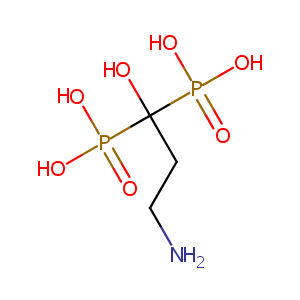| 1 |
Recurrent recessive mutation in deoxyguanosine kinase causes idiopathic noncirrhotic portal hypertension.Hepatology. 2016 Jun;63(6):1977-86. doi: 10.1002/hep.28499. Epub 2016 Mar 31.
|
| 2 |
Natural products as sources of new drugs over the last 25 years. J Nat Prod. 2007 Mar;70(3):461-77.
|
| 3 |
Pamidronate FDA Label
|
| 4 |
URL: http://www.guidetopharmacology.org Nucleic Acids Res. 2015 Oct 12. pii: gkv1037. The IUPHAR/BPS Guide to PHARMACOLOGY in 2016: towards curated quantitative interactions between 1300 protein targets and 6000 ligands. (Ligand id: 7259).
|
| 5 |
Drugs@FDA. U.S. Food and Drug Administration. U.S. Department of Health & Human Services.
|
| 6 |
Treatment of patients with ethylene glycol or methanol poisoning: focus on fomepizole. Open Access Emerg Med. 2010 Aug 24;2:67-75.
|
| 7 |
Chemical inhibitors of cytochrome P450 isoforms in human liver microsomes: a re-evaluation of P450 isoform selectivity. Eur J Drug Metab Pharmacokinet. 2011 Mar;36(1):1-16.
|
| 8 |
Detection of nonsterol isoprenoids by HPLC-MS/MS. Anal Biochem. 2008 Dec 1;383(1):18-24.
|
| 9 |
Pamidronate increases markers of bone formation in patients with multiple myeloma in plateau phase under interferon-alpha treatment. Calcif Tissue Int. 2001 May;68(5):285-90.
|
| 10 |
Bisphosphonates pamidronate and zoledronic acid stimulate osteoprotegerin production by primary human osteoblasts. Biochem Biophys Res Commun. 2002 Mar 1;291(3):680-6. doi: 10.1006/bbrc.2002.6510.
|
| 11 |
An in vitro and in vivo study of cytokines in the acute-phase response associated with bisphosphonates. Calcif Tissue Int. 1997 Nov;61(5):386-92. doi: 10.1007/s002239900353.
|
| 12 |
Expression profile and synthesis of different collagen types I, II, III, and V of human gingival fibroblasts, osteoblasts, and SaOS-2 cells after bisphosphonate treatment. Clin Oral Investig. 2010 Feb;14(1):51-8. doi: 10.1007/s00784-009-0312-2. Epub 2009 Jul 14.
|
| 13 |
Bisphosphonates induce apoptosis in human breast cancer cell lines. Br J Cancer. 2000 Apr;82(8):1459-68. doi: 10.1054/bjoc.1999.1131.
|
| 14 |
Pamidronate induced anti-proliferative, apoptotic, and anti-migratory effects in hepatocellular carcinoma. J Hepatol. 2006 Jan;44(1):142-50. doi: 10.1016/j.jhep.2005.09.022. Epub 2005 Nov 9.
|
| 15 |
Nitrogen-containing bisphosphonates induce apoptosis of Caco-2 cells in vitro by inhibiting the mevalonate pathway: a model of bisphosphonate-induced gastrointestinal toxicity. Bone. 2001 Oct;29(4):336-43. doi: 10.1016/s8756-3282(01)00589-0.
|
| 16 |
The role of fibroblast growth factor 23 for hypophosphatemia and abnormal regulation of vitamin D metabolism in patients with McCune-Albright syndrome. J Bone Miner Metab. 2005;23(3):231-7. doi: 10.1007/s00774-004-0589-9.
|
| 17 |
Caspase-independent induction of apoptosis in human melanoma cells by the proapoptotic Bcl-2-related protein Nbk / Bik. Oncogene. 2005 Nov 10;24(49):7369-80. doi: 10.1038/sj.onc.1208890.
|
|
|
|
|
|
|


